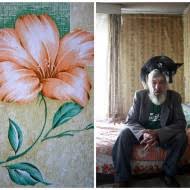Kendrick Brinson is a young freelance photographer based in Atlanta, Georgia. Her current photographic emphasis focuses on photographing the eccentricities, stereotypes and romanticism of the Deep South of America.
She is also a founding member of Luceo Images, a photo collective of like-minded passionate photographers. Her personal photoblog is Box of Light.
Following text and photos by Kendrick Brinson.
I should preface this by explaining that I was born in South Carolina, the belly of the Deep South of the United States. Growing up, I visited my father’s family’s farm twice a year, a rural bicentennial cotton farm in rural Georgia. Every summer and Christmas, my cousins and I would pile into the back of my grandfather’s pickup truck loaded with dogs and wind through those fields on dirt roads, on Sundays ending up at a one-room church. My father, Buck, Jr., grew up in a home surrounded by fields where sharecroppers lived in shacks. There’s no doubting my Southern roots.
The first image that illustrates this article was taken at that same family farm in Georgia during the cotton harvest. The huge cotton bale behind Rebecca contains enough cotton to make over 1,000 t-shirts. The bale is just one of many that have been harvested over this rural Georgia family farm’s more than 200 year history. Cotton grew on that farm in the 1800s when cotton was king in the USA and it was the economic lifeblood of the region before during and after the American Civil War. The woman in this photo represents a shifting of the culture of the South. Her family’s ancestry lies in these fields, yet she grew up in a city hundreds of miles away. She does not identify herself as a stereotypical Southerner– she lacks a slow Southern accent, she votes Democratic, she is well-educated, she lives in a city. This photograph is just one of several I have taken for a long-term documentary project I am working on focusing on the overstated and understated stereotypes of the deeply proud Southern subculture.
As a region, the Deep South is rich in culture, history and charm and long on stereotypes. Despite where my roots were planted, a deeply proud southerner I am not. I was raised by my mother, a liberal military brat, and understood at a young age that the Confederate flag shamelessly boasting a failed win in the Civil War flying atop the South Carolina State House was a matter of shame and not pride. I am an insider with an outsider’s perspective. Like Rebecca, I reject the subculture I was born into and so will many of the next generations born in the Deep South. Yet, the region’s history, and those who hold on to the history with pride, is what fascinates and intrigues me.
Documentary photography is such a passion of mine because I love meeting people and hearing their stories. Using a camera is an intimate entry into people’s lives. For this essay, I’ve photographed a cotton harvest, a Civil War reenactment, self-proclaimed rednecks drunken mud wrestling, a devoted barbecue restaurant owner adorned in a yellow suit and a top hat, and I plan to photograph much more. The people in this region are as uniquely photogenic and colorful as their accents. I will document festivals named after greasy soul food; women with too much hairspray and acrylic Lee nails who win beauty pageants; men carrying artillery swords at Civil War reenactments; good ole boys campaigning and shaking hands in the republican states; four generation family reunions; baptisms in the Bible Belt; debutantes professing their purity in matching white dresses; leather-skinned farmers driving down rows of cotton atop their combines. I do not relate to these people, but I am fascinated by Southern loyalty and Southern tradition. They are a colorful, eccentric breed. This documentary essay is not only a visual exploration of Southern pride, but also an exploration of my own regional history.
The Southern United States is one of the fastest growing areas in the country . As the region grows, the regional identity changes and will continue to evolve as time passes. Regional subcultures of the entire US are becoming more and more homogenized through the mainstream and the traditions that make this area of the country unique will fade. Until recently, the stubborn regional loyalists of the Deep South could reject the impending transitions, but now the regional culture and its traditions must evolve or dissolve due to the unstoppable motion of shifting demographics.
Documenting people and events with photography is a way of preserving history. As a former newspaper photographer, my passion for photojournalism is linked to my duty to visually record the daily mundane and exceptional events to preserve history and to show the community what has happened and what is happening during that very moment of time. Photography is a way of freezing and preserving memories and feelings and moods and cultures as time erodes each.
What traditions may be lost as more Northerners relocate and retire in the South? Or as Southern families relocate to the North for better educations or jobs – as black diaspora of the 1930s and 1940s did for their children. What will become of my grandparents’ bicentennial farm? What part of my own family history, which is rooted so deeply in the South, will die when the banks no longer support my grandparents’ farm? What happens when their cotton fields and oaks with Spanish moss are paved over?
As Latino populations and New Englanders relocate to the American South for work or retirement, these denizens will continue to grow and overshadow the stereotypical South. From 2000 to 2006, of the top 50 fastest growing metropolitan areas in the US, 25 were in the South. Arkansas saw an increase of 47 percent in Hispanic population, the highest increase in the country from 2000 to 2005. In 1950, Hilton Head Island had 300 residents, all black, the descendants of the slaves who worked the Sea Island cotton plantations. In 2000, the population was 28,893 and 85 percent white. The subculture of the South is not frozen in time; it is growing and changing. Soon the aging traditions of the Deep South will take on other cultural ingredients to make a new South. As much as I don’t relate to those who still claim to be proud Southerners, I also hate to see the cultural traditions and characteristics of the Deep South fade with time. Photographs will preserve what time and change take away.
As a Southerner critical of, yet sympathetic to, my neighbors, I believe I am perfectly positioned to witness and document this subculture. And it’s an adventure of twangs and fried food and dirt roads along the way.
The very story of the South is a story of unresolved identity… The South, contrary to so many words written in defense and in attack, was not a fixed, known, and unified place, but rather a place of constant movement, struggle, and negotiation.
Edward Ayers, Southern Historian
Fabiano Busdraghi: You say several times that there are a lot of stereotypes in the deep south. maybe everyone from US knows exactly what you mean, but maybe it is not the same here in Europe. Would it possible for you to describe the southern culture, its stereotypes and particularities? Could you gave us a little bit the taste of what is the southern world and culture?
Kendrick Brinson: The Deep South refers to a region in the United States, but also, to some people a slower pace of life. This geographical region usually includes Alabama, Georgia, Louisiana, Mississippi and South Carolina — these states, plus Texas and Florida, made up the Confederate States of America, as each seceded from the United States before the Civil War. For whatever reasons, since the Civil War, the South has been riddled with stereotypes. Whether its residents be thought of as slow, or polite, or stubborn, these stereotypes have permeated through time in people’s minds, and popular culture.
A stereotypical southerner is an Evangelical, they speak with an accent– a twang, they eat fried food and drink sweet tea and whiskey. They usually hail from small towns. They are proud, they vote conservatively. They are shirtless, toothless, barefoot, and uncouth. They worship the Civil War and drive pick-up trucks with the Confederate flag plastered on their bumpers. They are proud of being from the South.




































souths gonna rise kendrick. love your work. i heard about the the layoff and i’m sorry to hear it, but don’t sweat it you have gobs of talent my friend, good thing are ahead for you.
You can also subscribe to this post comments RSS feed.